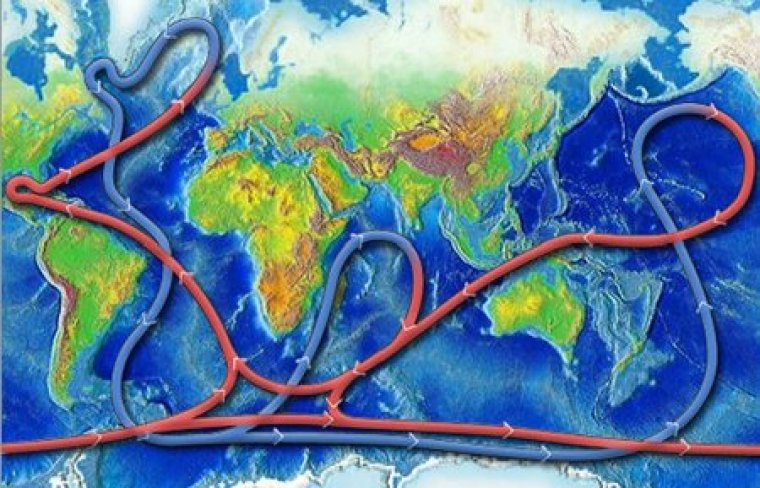| News / Science News |
A new study is the first to measure the time lags between changing ocean currents and major climate shifts.
In the Atlantic Ocean, a giant ‘conveyor belt’ carries warm waters from the tropics into the North Atlantic, where they cool and sink and then return southwards in the deep ocean. This circulation pattern is known as the Atlantic Meridional Overturning Circulation (AMOC) and it’s an important player in the global climate, regulating weather patterns in the Arctic, Europe, and around the world.

Global Ocean Conveyor Belt. Photo credit: NOAA/National Ocean Service
Evidence increasingly suggests that this oceanic current system is slowing down, and some scientists fear it could have major effects, such as causing temperatures to dive in Europe and warming the waters off the eastern coast of the USA, potentially harming fisheries and exacerbating hurricanes.
An international team of scientists studied one of the key sections of the AMOC –where North Atlantic water sinks from the surface to the bottom of the ocean. They confirmed that changes in the ocean conveyor belt preceded abrupt and major climatic changes during the transition out of the last ice age, referred to as the last deglaciation.
The team pieced together data from a sediment core drilled from the bottom of the Nordic Seas, a lake sediment core from southern Scandinavia, and ice cores from Greenland.
Scientists typically rely on radioactive carbon (carbon 14) dating to determine the ages of sediments. This relationship is tricky in ocean sediments, though, because carbon 14 is created in the atmosphere, and it takes time for the carbon to make its way through the ocean. By the time it reaches the organisms at the bottom of the water column, the carbon 14 could already be hundreds or thousands of years old.
The researchers solved this puzzle by measuring carbon 14 levels from a nearby lake sediment core and matching it to the marine core layers. Next, they compared the real age of the marine sediments to the deep ocean carbon 14 measurement, giving them a record of ocean circulation patterns in this region over time. The final piece of the puzzle was to analyse ice cores from Greenland, to study changes in temperature and climate over the same time period.
Comparing the data from the three cores revealed that the AMOC weakened in the time leading up to the planet’s last major cold snap around 13,000 years ago. The ocean circulation began slowing down about 400 years before the cold snap, but once the climate started changing, temperatures over Greenland plunged quickly by about 6 degrees.
A similar pattern emerged near the end of that cold snap, transitioning out of the ice age; the current started strengthening roughly 400 years before the atmosphere began to heat up dramatically, when Greenland warmed up rapidly — its average temperature climbed by about 8 degrees over just a few decades, causing glaciers to melt and sea ice to drop off considerably in the North Atlantic.
For now it’s not fully clear why there was such a long delay between the AMOC changes and climatic changes over the North Atlantic.
It’s also difficult to pinpoint what these patterns from the past could signify for Earth’s future. Recent evidence suggests that the AMOC began weakening again 150 years ago.
However, current conditions are quite different from the last time around: the global thermostat was much lower back then, winter sea ice stretched farther south than New York Harbour, and the ocean structure would have been much different. In addition, the past weakening of the AMOC was much more dramatic than today’s trend so far. (University of Cambridge)
YOU MAY ALSO LIKE




